This post may contain affiliate sales links. Please read my disclosure policy.
Today’s tutorial is all about how to frost a smooth cake. Getting that nice, smooth finish when icing a cake can take some practice, but I have been asked so many times about how I get my icing so smooth, I’ve finally put together some instructions that I hope will be helpful. Just remember you have to be patient. My first cake did not look like my current cakes. It took practice – and the right tools.
Want to frost cupcakes? See my post on how to beautifully frost your cupcakes!

Watch How To Do It
So to start, let’s talk about the tools you’ll need:
Icing tips (Wilton #789 for icing the sides and Ateco 844 for piping the border)
Icing bags
Turntable (I use Wilton Trim-N-Turn Ultra Cake Decorating Turntable)
Icing smoother (I 100% recommend Ateco Decorating Comb over any other)
9 inch offset spatula (I use Wilton Angled Spatula)
Fondant smoother (I use Wilton Easy Glide Fondant Smoother)
Viva paper towels (Viva brand specifically)
Let’s talk about that icing smoother for a second. I linked to it above, but it’s an Ateco smoother that costs less than $5. It is the best money I have ever spent on a tool. I used to use another one, but it was big and clunky and I had no idea how much it hindered my ability to get a nice, smooth cake until I tried this one. It’s lightweight, small and easy to use.
In addition to those tools, you’ll obviously need a cake and some icing. I used regular American Buttercream (American Buttercream recipe here). For my cakes that are about this size, I go through about 2 1/2 recipes worth.
For this tutorial, I started with a cake that was already crumb coated and had a layer of icing on the top of the cake. It’s important to already have the top layer on the cake and get it as smooth as you can with your offset spatula. It’ll get further smoothed later, but it’s best to have it smooth now too.
The crumb coat isn’t entirely necessary for every cake. Typically chocolate cakes are more likely to need them, since they tend to have more crumbs. But because of the way I add my icing, it’s not always necessary. I use an icing tip and bag, which reduces crumbs mixing into the icing.

How to Frost a Cake
So to get started from here, you’ll want your icing bag fitted with the Wilton #789 icing tip and filled with icing. Starting from the bottom of the cake, pipe icing around the edge, trying to keep even pressure on the bag so that the layer of icing is even.
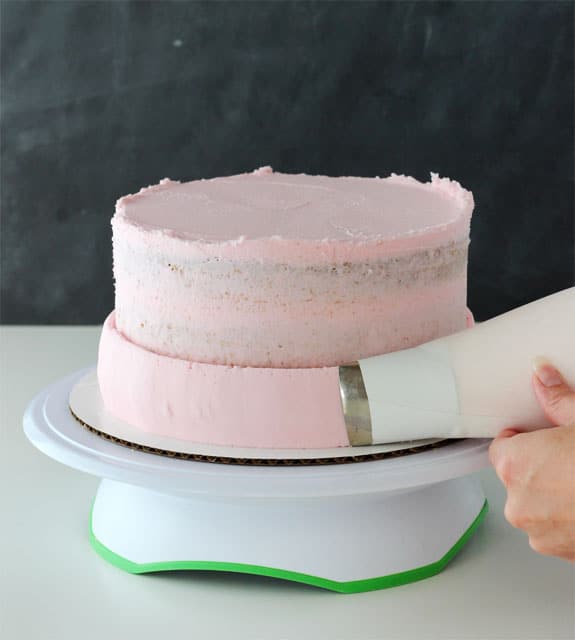
You’ll have multiple layers of piped icing, depending on the height of your cake. The top layer needs to stick above the top edge of the cake. This will be important later for smoothing the top edges/corners of the cake.

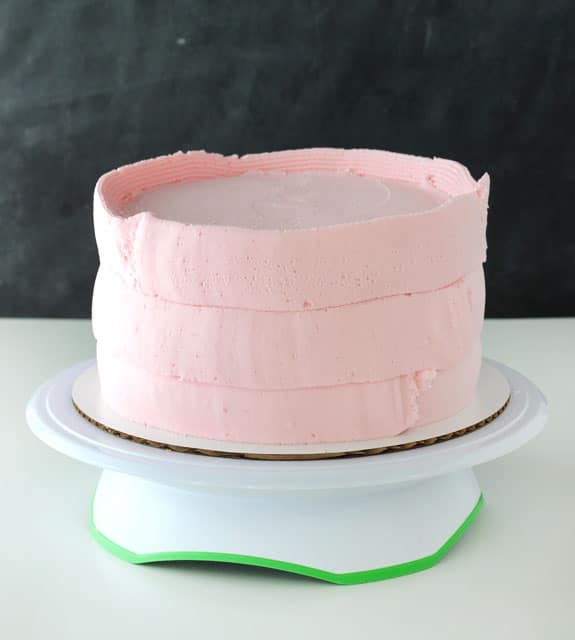
When you are done applying the icing to the sides of the cake, it’s time to smooth it. This is where the icing smoother comes in. Place it against the side of the cake. You want to hold it straight up and down, as straight as possible. Hold your icing smoother in the same place and use your other hand to turn the turntable. Continue to turn the turntable, scraping the icing off of the smoother occasionally so that there isn’t too much buildup. I clean off my smoother regularly and when I scrape the excess icing off of it, I usually also wipe it with a paper towel, so that there isn’t anything left on there that will mess up the icing once I place it back on the side of the cake.

Here is an image showing the angle at which I hold the smoother. I really believe the angle makes a big difference in the way the icing smooths. Do not hold it at 90 degrees. The tighter the angle (like shown), the better the excess icing pulls around the cake and fills in gaps.

After doing a few turns of the turntable, you’ll notice some gaps that are deeper and should probably be filled in. I usually notice it at the “seems” where the three layers of icing were piped on. At this point, use your offset spatula to add some icing to the gaps. You’ll want to have a little excess icing, rather than too little.


Begin smoothing the sides again, pulling the excess icing around the cake to fill in gaps, then wiping off the icing smoother as needed.


Continue working around the outside of the cake, pulling the icing, then scraping it off of the icing smoother. You can fill in more gaps if needed, just keep working the sides until you are happy with it.

You should end up with a cake that looks like this. The sides are mostly smooth and the excess icing from the top is still sticking up above the cake. In some places you may have tiny little holes from the air in the icing. The angle that you hold the icing smoother can make a difference in how many of those you end up with. Again, tighter angle is better. Also, some of those will fill in as we smooth the sides again later with a paper towel.
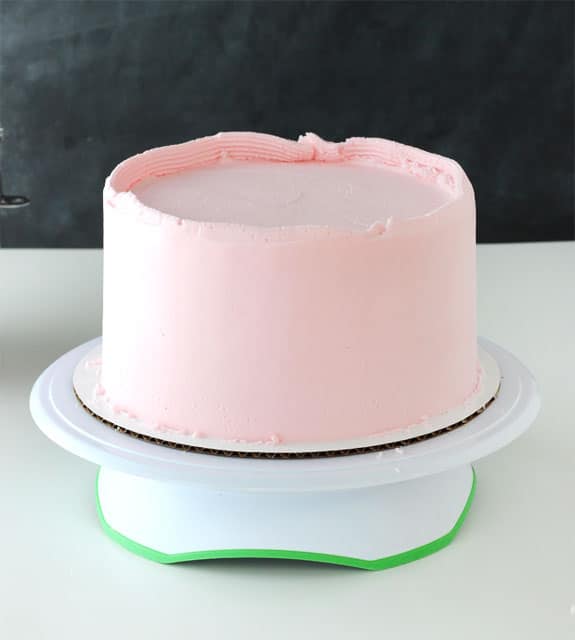
Next is always the scariest part! The top edges/corners. It was even harder to do these while taking photos. 🙂 The whole icing process took longer than normal, so my icing started to crust a bit and so it’s a little drier in the photos than yours should be at this point. You want to work as quickly as you can. If the icing starts to crust, it’s harder to work with.
To do the edges, you can use the icing smoother or the offset spatula. I use either, depending on my mood, though often I do feel like the offset spatula gives me more control. Pull the icing in towards the middle of the cake, making the corner level with the top of the cake. The spatula should be at about a 45 degree angle. The excess icing should help fill in any uneven-ness on those top corners as you pull it in.


Go all the way around the cake, until it looks like the one below. Again, my icing is a bit drier than yours should be. Hopefully, your cake top is a bit smoother.

Use your offset spatula to continue to work the icing on the top of the cake and smooth the top edges. Do not mess with the sides or side part of the corners yet. Just try to get the top as smooth as you can, the sides should already be smooth.

Next, we use the paper towel to finish smoothing any imperfections that are left from the offset spatula. Like I said above, I ONLY use Viva paper towels for this. They are the only paper towel I know of that doesn’t have raised patterns on it. You’ll notice that one side is smoother than the other – that’s the side you want against the cake.
I usually start with the top of the cake, since it tends to be rougher and need more work. Along with your paper towel, you’ll need the fondant smoother. Place the paper towel on the cake, smoothest side down, and rub in small circular motions with the fondant smoother to smooth out the icing. Press firmly and evenly, but not hard.

Do the same with the sides of the cake, evening out any bumps or air holes.

To help make sharper corners, place the paper towel on the top of cake, letting it hang over the edge and down the side. Placing your fingers against the side of the cake to keep the icing in place, use the fondant smoother to gently push the icing out towards to edge to help make that corner sharp. Do that anywhere you think the edges could use it.

Keep working that paper towel and fondant smoother until you are happy with your cake.

Next, I like to take my offset spatula and remove excess icing at the bottom of the cake and give it a clean edge. The spatula is placed at an angle so that nothing is actually touching the side of the cake, but just the bottom of the spatula side is grabbing the excess icing. Then pull the excess towards you and away from the cake.
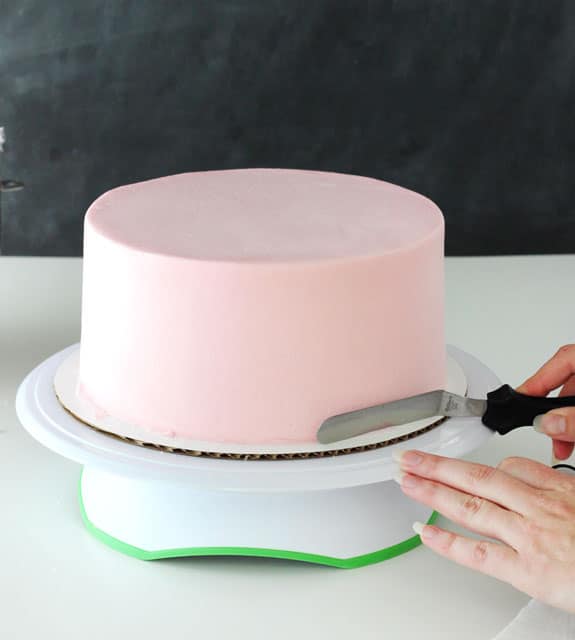
Use your other icing tip to pipe on your border. I used Ateco tip 844, but you could also use Wilton 1M, which is similar, or any other tip you prefer.
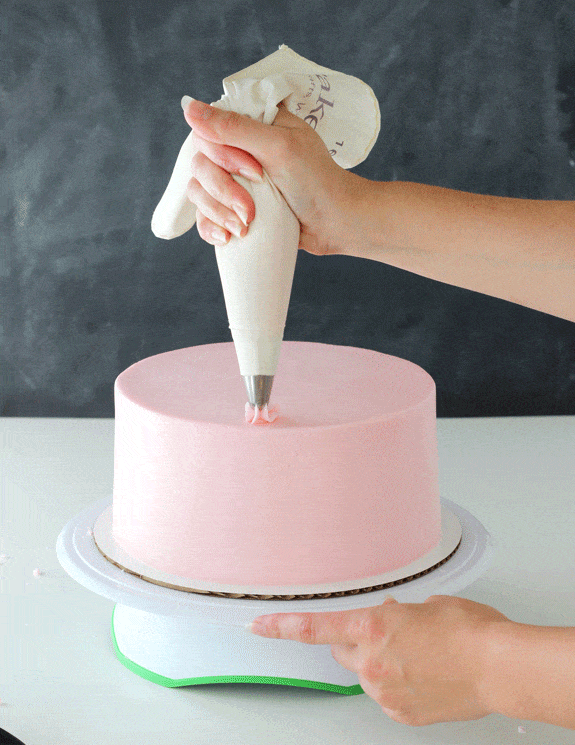
Sprinkle with some spraaaankles (I used Wilton Spring Confetti Sprinkles!
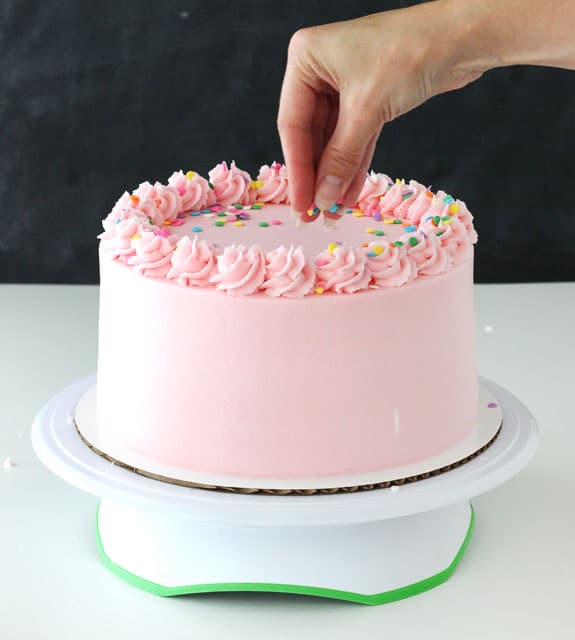
And you’re done! Put your cake on your favorite cake stand, add a few more sprinkles and dig in!! It’s time to eat all that hard work. 😉
*Update* For some help with getting the right frosting consistency, check out my new post, How to Get the Right Frosting Consistency, on how I like to do it.

This page includes affiliate links.

Learn how to decorate Sugar Cookies with Royal Icing
Practice your smoothing technique on some of these delicious cakes:
Moist and Fluffy Vanilla Cake
(the recipe for the cake in the tutorial above!)






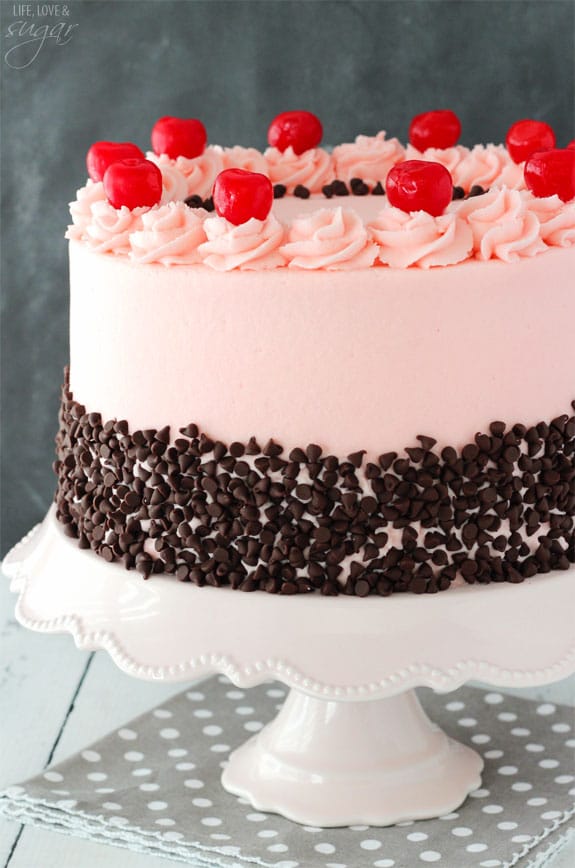



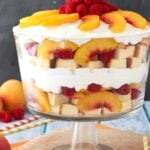








How does the frosting not stick to the paper towel?
It’s all about having the right frosting consistency.
Great video and pictures! I hadn’t tried the very fat nozzle for the sides before, and had only used a (hot) offset spatula. But the fat piping nozzle is obviously the way to go when you’re striving for smoothness. My question is actually about something different: you seem to be using some sort of platform on top of the cake turntable. One really wants such a thing, unless you’re going to serve the cake directly off the turntable, since removing the cake from the turntable is a very tricky (and messy, at least for me) job. You didn’t mention what these platforms were, and I wonder if they are easily available?
Glad you enjoyed the tutorial. The cake is sitting on a cardboard cake circle.
Learnt so much from this tutorial along with all the comments. thank you from zambia!
so good instruction. But are all these tools really necessary? Can you provide More accessible alternatives ?
These are the tools I settled on after trying many. I find them to work best to give the best result. As far as this tutorial is concerned, they are the ones I recommend and would deem “necessary” so to speak. They should be pretty accessible, for the most part. I’ve provided Amazon links, but many of the Wilton products can also be found at craft stores like Michaels and even Walmart. The Ateco products are usually also available in stores at Sur la Table.
I looove your blog and his tutorial in particular is really fantastic! I hope you do more tutorials… you are quite gifted at it! I’m writing because my sons first birthday is coming up and I’m doing the cake! I wondered if you could offer some insight as to whether the type of frosting is negotiable for this technique. I want to use a recipe for frosting that includes cream cheese. Is there a reason you use buttercream icing? Is there a disadvantage to cream cheese icing. Here’s my fav cream cheese icing recipe:
1 stick unsalted butter, softened
4 oz. cream cheese, room temperature
5 cups confectioner’s sugar
1/4 teaspoon salt
1/4 cup half-and-half {original recipe calls for whole milk, but I like to use this instead}
1/2 teaspoon vanilla
I’m so glad you’ve enjoyed the blog and tutorial! Cream cheese frosting is a little more tricky because it is usually sticky from the cream cheese. I use the same method for cream cheese frosting, up until the paper towel which would stick to the frosting.
I read more of the comments that other people left after I left the comment to you and found that you’d already answered this question before. I felt bad then. Thanks so much for getting back to me. Really love your blog. Looking forward to more tutorials!
So good instruction. Thanks. Can i use other tools for frosting? please tell some simple tools for frosting….
Hi christin from nigeria pls i want to ask is this butter icing or royal icing? Cos the way u smoothen it with the paper towel kept me wondering
It’s a buttercream, not royal icing.
Thank you so much for the tutorial! I’m a self taught cake decorator and it’s tutorials such as yours that has helped me iron out some lumps and bumps (pun intended!) of the cake decorating world – I will be using your tips going forward! I can’t wait to do my next cake 🙂
Hi Lindsay! Your site is so helpful that I bought a few more stuffs like yours such as the cake icer and smoother. It made my life easier with decorating cakes! Quick question though, I rarely use buttercream as I find them too sweet so I always opt for frostings with cream cheese , mascarpone or whipping cream. Will this smoothing technique work with these kinds of frostings that I use? Thanks in advance!
I’m glad you find it helpful Tessa! This technique probably won’t be great with those other types of frosting because of the way it would stick to the paper towel. Everything else will be fine, but the paper towel smoothing won’t be successful.
I have tried and tried techniques for smoothing a cake, but always fail. When trying this method with using the paper towel…. the icing is always lifted with the paper towel when I go to remove it. SOS!!!!!
It sounds like the consistency of the frosting is the issue. Check out this post for more info on that. 🙂
I love the look of your site. I agree that you need a great go to vanilla cake. I have been looking for one. I am trying out the cupcakes. They are in the oven and smell wonderful. I also like your icing tutorial.
I usually use Russian piping tips for frosting such big cakes.
Very easy to use it as for me the biggest problem before was to make flowers 😀
Btw I like your tutorials a lot. I learned many good techniques. Thanks for that.
I found this so helpful. I wonder if you would consider doing a video showing how you level the cakes. Yours are so perfectly level before frosting. Thank you!
Oh my gosh! This is my first time commenting on a tutorial and I’m doing so because this was awesome! I was totally engaged from the starting to the ending instructions. You made this feel so effortless for a beginner like me; I thank you!
I’m glad to hear it! Thanks Luciana!
I have never decorated a cake before but would say all around I’m a pretty crafty gal. I did some research before starting and came across your blog. I used your vanilla frosting recipe and this tutorial. This was so helpful. I love the way the cakes turned out. Thanks!
Renee
I enjoyed your tips on icing a cake. I am wondering why you use a paper towel and not a piece of parchment paper.
Parchment paper tends to wrinkle for me, but you could try it.